1956 Italian Grand Prix race report: Moss masters Monza; Fangio wins fourth title
Stirling Moss takes his second win of the year; Fangio claims his fourth title after Collins sportingly gives the Argentine his car
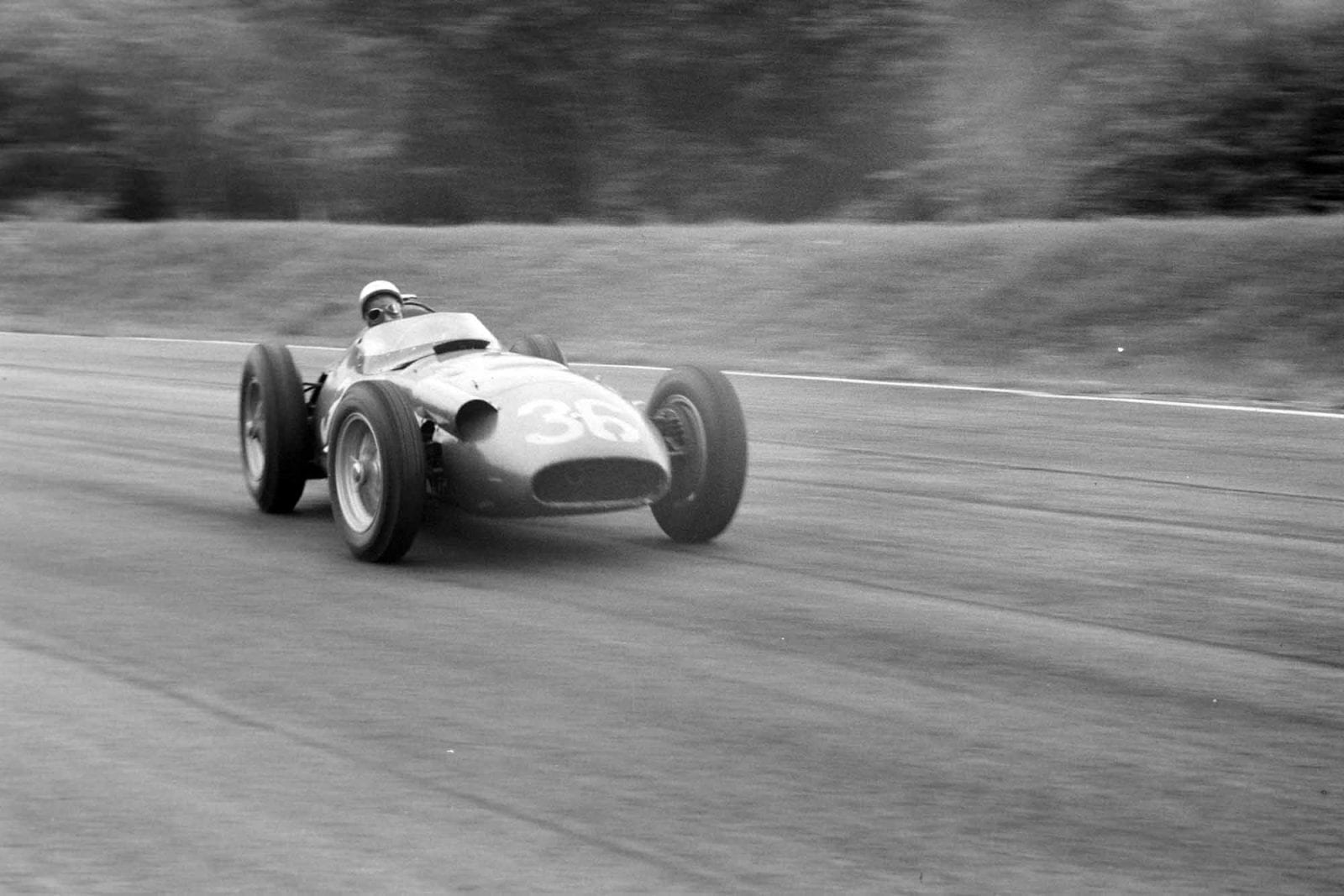
Stirling Moss finds the limit of adhesion and beyond on his way to victory
Motorsport Images
THIS year the Italian Grand Prix took the title of the Grand Prix of Europe and was held as usual at the Monza Autodromo near Milan. This event was the last in the 1956 World Championship series and for that matter the last serious Grand Prix event of the year, so everyone, with the exception of BRM and Bugatti, were out for a final win-or-bust effort, knowing that the rest of the year was available for making amends should the attempt prove disastrous.
Being open all the week the Autodromo was in full use during the days preceding the official practice, Ferrari, Maserati and Vanwall taking turns to try their cars, those from Maranello and Acton being basically unchanged since their last appearance and the Modena firm having a new model. The Scuderia Ferrari were very confident and well satisfied with their V8 cars, while Vanwall were anything but happy and Maserati were hopeful.
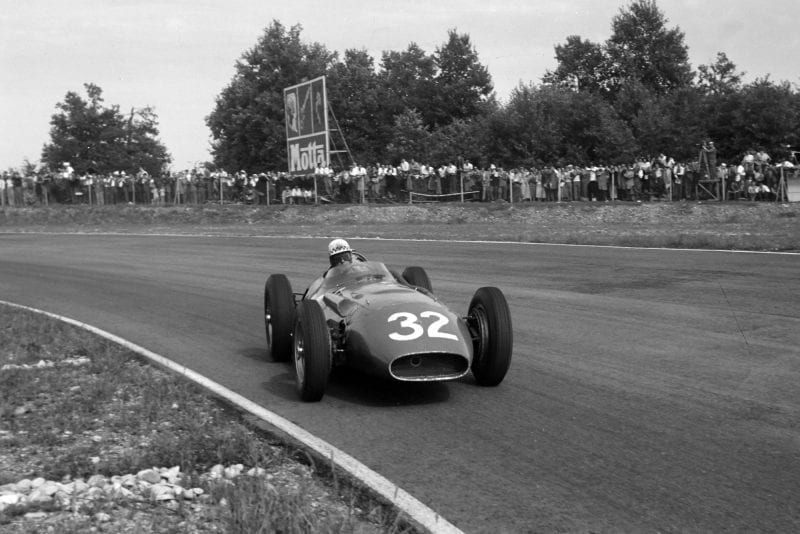
Jean Behra qualified his Maserati 250F in fifth at his team’s home race
Motorsport Images
Qualifying
Friday afternoon was the first official practice period and there were six Lancia Ferraris out, with Fangio, Colllins, Castellotti, Musso, de Portago and von Trips, the first five being entered as the official team with the German driver as reserve, though if the two days of practice finished without the loss of a car then all six would run in the race.
Maserati had their two new cars out for Moss and Behra, the latter’s still unpainted, and in addition a normal 250/F1 with fuel injection and two similar cars with carburetters. As Perdisa’s Nurburgring crash had proved more serious than at first imagined, he was still unable to drive and his place was taken by Villoresi, with Maglioli added for luck.
Vanwall entered three cars, with a fourth one standing by as spare, and the drivers were Schell, Trintignant and Taruffi, the major problem with the cars being to keep them in one piece over the high speed bumps around the bankings.
Connaught had three cars running, with Fairman, Leston and, it was hoped, Scott-Brown, but as the Italian authorities were not prepared to accept Archie’s physical disabilities, his place was taken by Flockhart, there being no BRM for him to drive.
To complete the factory teams there was Gordini with two eight-cylinders for Manzon and da Silva Ramos and a six-cylinder for Simon. This collection alone would have made a worthy field for a Grand Prix, but the list was enlarged even more by Graffenried with the Scuderia Centro-Sud Maserati, Gerini with the Scuderia Guastalla Maserati, Piotti, Godia, Salvadori, and Halford with their private Maseratis, making a total of 24 cars.
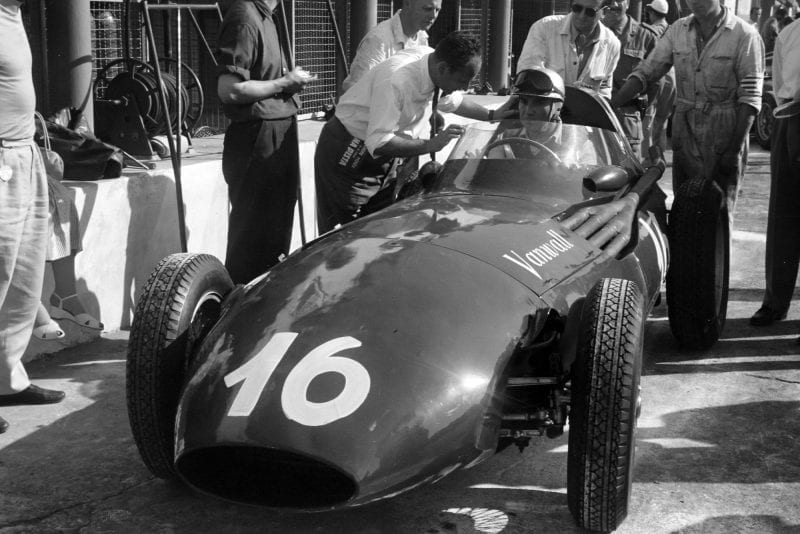
Taruffi qualified his Vanwall in an impressive fourth
Motorsport Images
The first practice session began to produce problems, especially for the Ferrari team, for they were running on 16-inch Englebert tyres, the same as they had tried last year, and once more they were having trouble with treads lifting when driving really hard round the bankings though they were lapping very fast and Fangio recorded an all-time fastest with 2 min 42.6 sec.
The Pirelli firm were refusing to let any of their customers run on anything but 17 inch diameter tyres as they were trying to prevent tyre troubles and this made it difficult for Connaught as they normally use special Dunlop wheels of 16 inch diameter and there were no 17-inch rims available of this special type. All the Maseratis were able to use 17-inch Borrani Wheels, so Connaught were in a quandary until Avon came along and agreed to let them run on their 16-inch tyres, being confident that they would take the high speeds on the banking.
Musso was really recovered from his broken arm and was right back on form, lapping in 2 min 43.7 sec, while Castellotti was next fastest with 2 min 45.2 sec. Apart from the tyre problems, the Ferrari team were going exceptionally fast and very reliably at that, whereas Maserati were not so happy, the new cars not being as quick as the Ferraris, while Behra’s new one kept boiling.
Moss was becoming happier with his car though it was his first introduction to it, not having been present during the trials earlier in the week, and in consequence the driving position did not really fit to his liking. The injection car was not being taken at all seriously and was soon discarded. Neither the Vanwall team nor the Connaught team were really in their stride on this first afternoon and apart from the tyre troubles Ferrari were in a very comfortable situation.
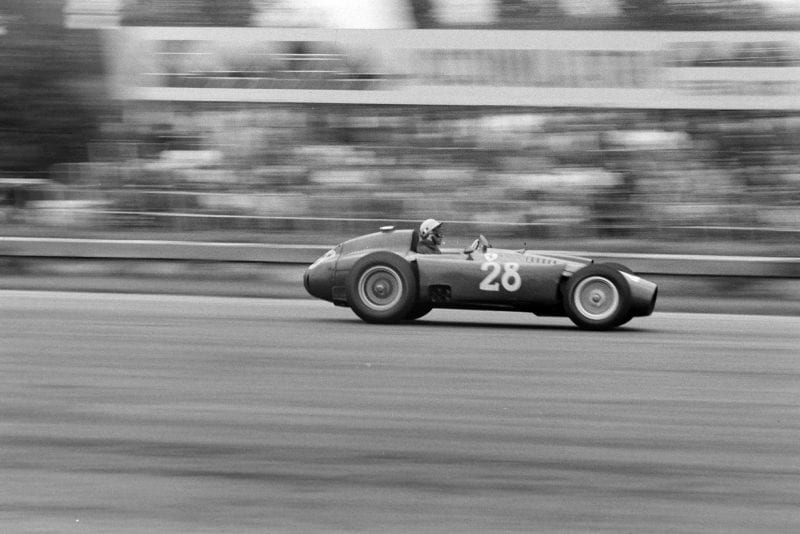
Musso found himself in a strong third place on the starting grid
Motorsport Images
On the Saturday afternoon everyone was out again, but conditions were a bit damp in places and Fangio’s fastest time of Friday was not approached, though the new Maseratis showed an improvement, Moss getting down to 2 min 45.9 sec which was nearly the equal of Behra’s best the day before, when he recorded 2 min 45.6 sec.
The Vanwalls were showing much greater promise and Taruffi did an excellent 2 min 45.4 sec during which his passage round the banked part of the track was hair-raising, the car leaping up and down the banking, a matter of nearly 6 ft Fangio did a few quiet laps in the 2 min 50 sec region as his previous best was clearly unbeatable, and von Trips was taking to his first Grand Prix car as if it were just another small sports car.
“While turning laps at just over 2 min 51 sec von Trips suddenly spun off into the woods in the middle of the Curva Grande”
While turning laps at just over 2 min 51 sec he suddenly spun off into the woods in the middle of the Curva Grande just after the start, while doing around 130 mph. Fortunately he was thrown out and escaped with scratches and bruises, but the car was a complete wreck, both front wheels being torn off and the engine castings split open.
Von Trips explained that the car seemed suddenly to dive to the right and he was sure he was not going too fast, but Ferrari smiled politely and put the written-off car into the garage and forgot the incident, counting it as part of the cost of training young and excitable drivers. Had they only known the real cause of the accident or taken the trouble to investigate there and then they could have saved themselves a lot of trouble which was to come during the race itself as we shall see later in this story.
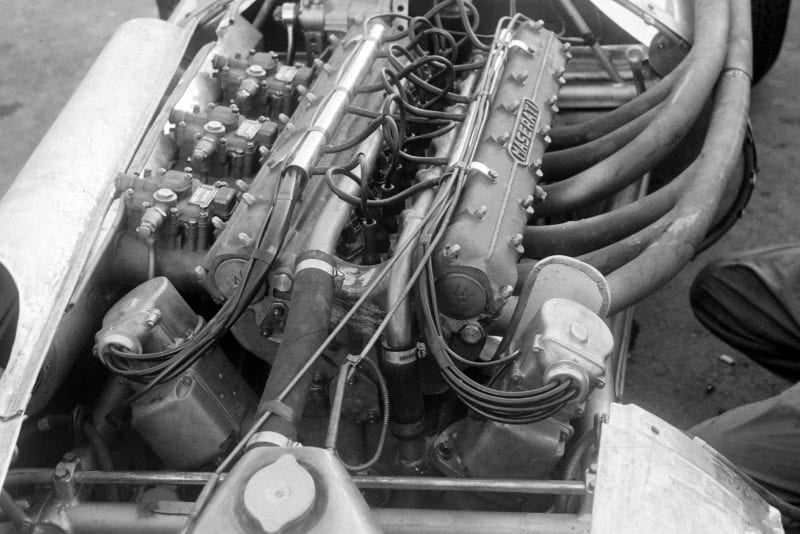
The Maserati 250F engine on show in the pit lane
Motorsport Images
Maserati borrowed Godia’s car to let the Swedish driver Bonnier have a few laps, as he was nominated as reserve driver for the team, and as none of the Maseratis on Pirelli tyres were having trouble it was hoped that Moss and Behra would stand a good chance of holding the Ferraris during the race. The Connaughts were not going very fast but were proving completely trouble-free, while the Vanwalls seemed much happier.
Race
On the morning of race day there was one continual downpour of rain, but by lunchtime the sun was out and when the Grand Prix cars lined up just before 3 pm the track was almost dry. In rows of three the 24 starters were put in position, to the accompaniment of a parade of national flags and anthems.
The order was: Fangio, Castellotti and Musso all on Lancia/Ferraris; then Taruffi (Vanwall), Behra and Moss (Maseratis); in row three Collins (Lancia/ Ferrari), Villoresi (Maserati) and Portago (Lancia/Ferrari, fitted with experimental 17-inch Englebert tyres); the next row contained Schell and Trintignant (Vanwalls), and Maglioli (Maserati); then Salvadori, Piotti (Maseratis) and Fairman with the first of the Connaughts; followed by Gerini, Godia and Graffenried; Leston, da Silva Ramos. and Halford; and in the back row Manzon, Flockhart and Simon
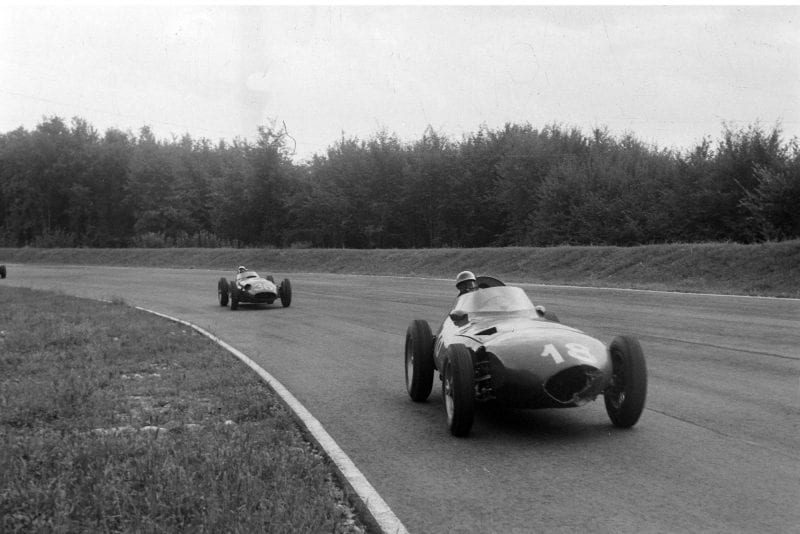
Schell leads Moss early on in the race
Motorsport Images
When the flag fell Musso led away, with Castellotti and Fangio in echelon, followed by Moss and Collins, but before the first lap was completed the green Vanwall of Schell was up amongst the leaders, and they went by in the order Castellotti, Musso, Fangio, Schell, Collins and Moss. This really was going to be an end-of-season battle and there were no holds barred, the Ferrari drivers threw caution to the winds and forgot all possibilities of tyre trouble, and Castellotti and Musso raced side by side having a very personal battle and completely overlooking any possibilities of team tactics.
Schell was holding a really terrific third place, leading Fangio, Collins and Moss, who were almost touching each other, while a few yards behind lay Taruffi, and already – after only two laps – there was a considerable gap before the rest of the field arrived, led by Behra and Portago having a wheel-to-wheel battle. Fairman was leading the Connaughts and all the private owners and Manzon stopped at the pits with a broken chassis frame.
“It was clear that Castellotti and Musso were out to win or blow each other up”
On the next, lap the leaders held the same positions with no increase at all in the separating gaps, and Villoresi stopped to change plugs and let Bonnier have a go in the car. On lap four Schell dropped from third to sixth place, but this was not serious as it meant only a matter of a few car lengths in this really close battle.
It was clear that Castellotti and Musso were out to win or blow each other up, and halfway round the fifth lap the trouble started, for both cars threw the left-side rear tyre tread, and as Moss, Fangio, Schell and Collins went by in a group, Castellotti and Musso slithered to a stop at the pits and screamed for new tyres. In a matter of seconds they were both back in the race but had dropped to 13th and 15th places, so fast was everyone going.
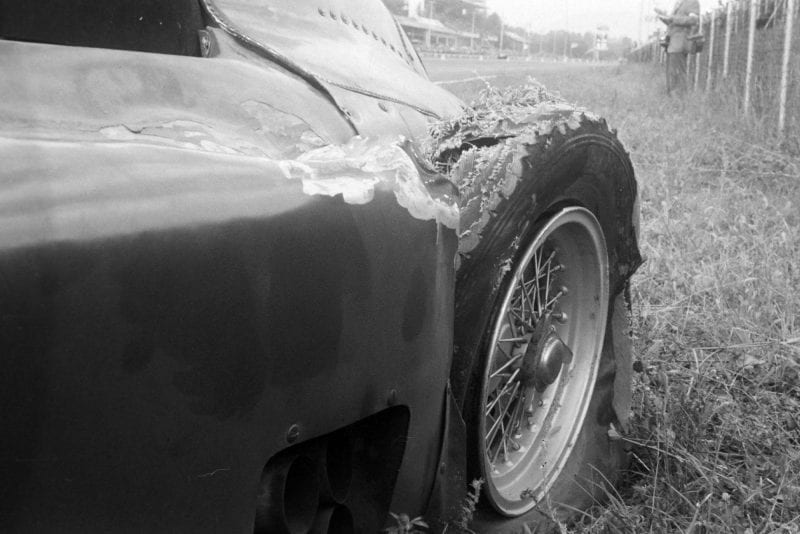
Many driver’s suffered tyre blow-outs, this failure of Castellotti’s particularly severe
Motorsport Images
On the very next lap de Portago had his left rear tyre tread come off and after a hair-raising 160 mph slide down the banking he motored slowly back to the pits, but could not continue as the suspension had been damaged. Then Leston retired with a stripped torsion-bar spline on the rear of the Connaught, and on the next lap Bonnier stopped with the Maserati sounding very flat and Salvadori came in to investigate a fuel leak in the auxiliary tank in the cockpit.
The fight for the lead was still going on unabated, with Schell and Moss passing and repassing, the Vanwall having to lift off on the banking but being much faster down the straights. Schell would lead at the end of the road circuit and Moss would then pass him round the banking, and meanwhile Fangio and Collins were sitting close behind, wondering how much longer their rear tyres were going to last.
Musso and Castellotti were making up time rapidly, going as hard as they knew how, Musso’s gear-changes as he passed the pits being so fast that there was no audible break in the exhaust note. Maglioli who was lying eighth, was being worried by the fact that his rear bonnet catches were undone but continued hopefully, and Halford was pouring out smoke front worn-out pistons. At the end of the ninth lap Taruffi was still holding a steady fifth place but then came into the pit, as oil was leaking from the transmission.
At almost the same moment Castellotti was screaming round the very edge of the south banking and about to join the finishing straight when once more his left rear tyre threw its tread and the car spun helplessly off the banking on to the infield, struck a barrier and ricocheted back on to the track and, still spinning wildly, crossed the inner track and came to rest on the grass, and a rather furious and somewhat shaken Castellotti got out completely unhurt.
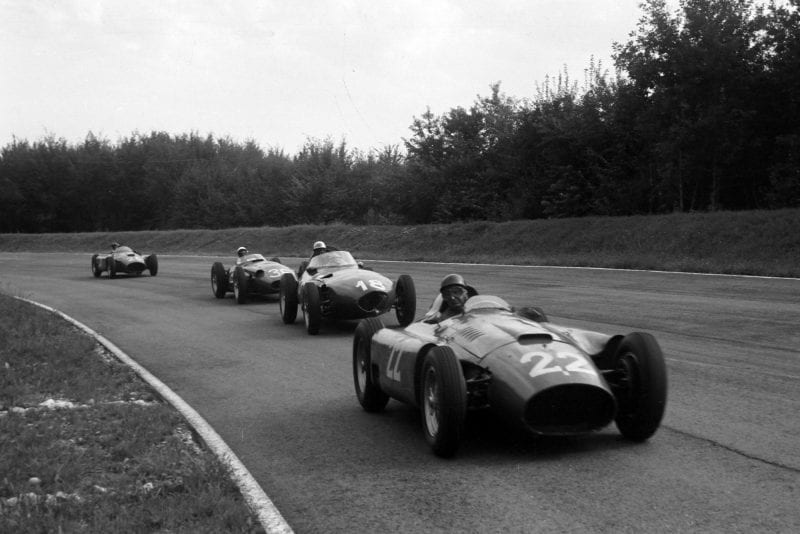
Fangio heads an intense battle with Schell, Moss and Collins
Motorsport Images
The race was now becoming fantasy and on lap 11 Collins had the left rear tyre burst and stopped at the pits. All these troubles were caused by the terrific centrifugal loadings due to the high speeds round the bankings, together with the roughness of the concrete.
At the end of this lap Schell managed to hold his lead for a full lap and the Vanwall was well and truly in the lead of the Grand Prix of Europe for the first time in history. However, Moss and Fangio were right on his tail, in the Maserati and Lancia/Ferrari respectively, and for the next six laps there was never more than a few feet between the three of them, the Vanwall once more proving itself the fastest existing Grand Prix car but not the most roadworthy.
“Fangio came slowly into the pits with his front wheels pointing in opposite directions, the right hand steering arm having broken”
Taruffi was still at the pits, and then Trintignant retired with broken front spring mounting and Fairman came in with his left front tyre in shreds. Musso and Collins were still making up time and were lying fifth and seventh, respectively, while eighth place was now a wheel-to-wheel battle between Flockhart and Godia, first one leading and then the other.
Taruffi restarted, did one lap and retired, the oil leak from the rear still being impossible. On lap 18 Musso passed Behra and took fourth place, and on the next lap Ferraris started a new series of troubles, for Fangio came slowly into the pits with his front wheels pointing in opposite directions, the right hand steering arm having broken.
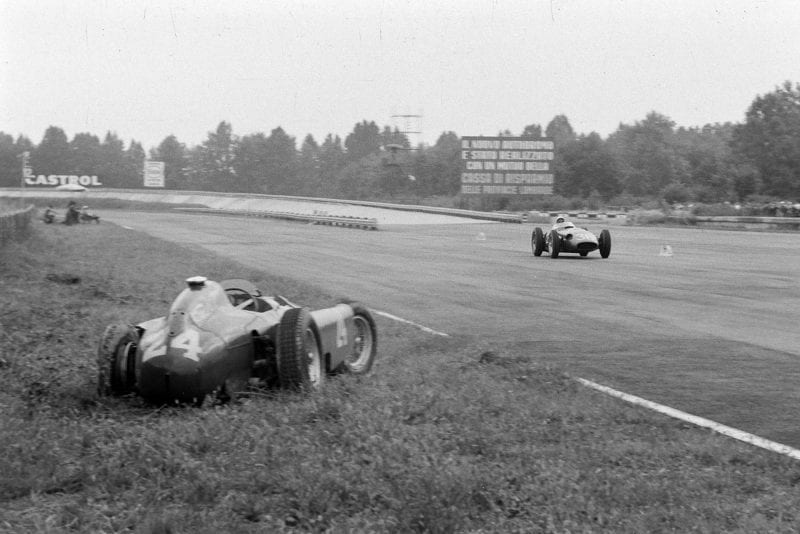
In a race of attrition, Moss passes Castellotti’s abandoned Ferrari
Motorsport Images
At the same time a shower of rain fell and Schell, quite reasonably, was not brave enough to keep up the pace in the prancing Vanwall on a wet track, and Moss then drew away into a comfortable lead of 10 sec. In less than half the race distance the whole Ferrari team had now suffered trouble, though only Fangio managed not to burst a tyre, which he made up for with the broken steering arm.
Although the shower of rain lasted only three laps it completely sorted out the order of things, and Moss was now the length of the finishing straight ahead of Schell, with Musso in third place, followed by Behra, Collins, Maglioli, Flockhart, Gerini and Fairman, the others trailing along in the rear. Moss lapped Flockhart and then Behra retired at the pits with a faulty magneto and, it was also discovered, a split fuel tank.
Maglioli was then flagged in and the car given to Behra, but before it was noticed that the bonnet was still undone the Frenchman had gone. As soon as he reached maximum speed the rear of the bonnet lifted and on the next lap Behra stopped to have it re-fastened, not knowing that Maglioli had been running most of the time with it undone. This was exactly half distance, or 25 laps, and Moss was sitting comfortably in the lead by 13 sec from Schell, who was leading Musso by 16 sec, with Collins another 55 sec behind in fourth place; these four being the only ones on the same lap.
On the 28th lap Schell came in for a refuel, as he had started with the tank only half full of fuel in order to reduce the load on the rear suspension, and in a few seconds he was tanked up and off again, though now in third place, just ahead of Collins. During the stop it was noticed that Schell was soaked in oil almost to the waist, so that his terrific opening battle with Moss and Fangio was all the more heroic.
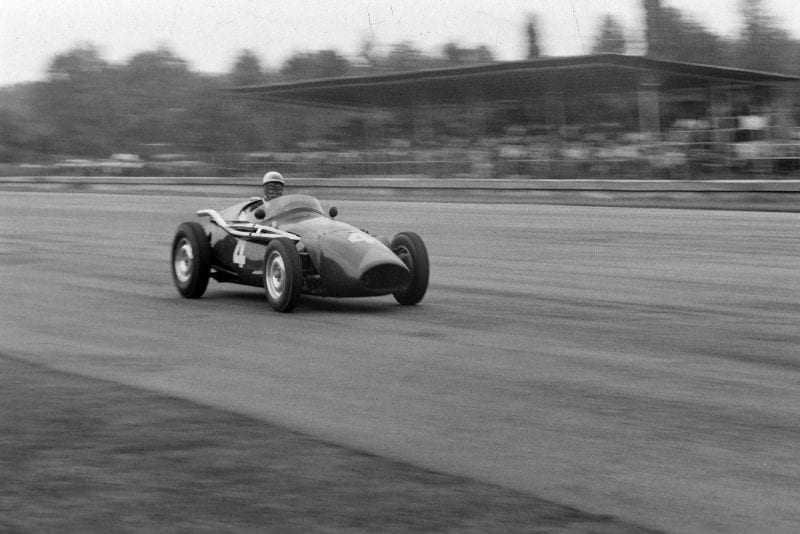
Flockhart on his way to the final podium position
Motorsport Images
Castellotti had rejoined the race in Fangio’s car, which had had the steering arm off Portago’s crippled car fitted to it, and he deserved a medal for bravery for the way he continued to drive knowing full well that another tyre might go, or the other steering arm might break. Both he and Musso were called in for a tyre inspection on lap 30, the latter having a front one changed, and Fangio stood by to take over if Musso had been feeling tired, this being his first full-length race since his accident. However, he was fit so he continued. Collins got past Schell and then the Vanwall showed signs of seizing its final drive, the car snaking to a stop just beyond the pits and an oil-soaked Schell trudged wearily back to the pits, to the accompaniment of terrific ovation from the crowd.
“Castellotti deserved a medal for bravery for the way he continued to drive knowing full well that another tyre might go, or the other steering arm might break”
This left the order Moss, serene as ever, Musso still going hard, Collins, and then, through sheer regularity and lack of trouble, Flockhart in fourth place, though a lap behind the leaders: Behra, in Maglioli’s car, was in fifth place, closing up fairly rapidly, and following came Godia, slowed slightly by a defective front shock absorber, and Fairman running like a train. Salvadori was back in the race after a long stop to remove the leaking auxiliary fuel tank, and Piotti, Graffenried and Simon were all still going.
On lap 35 Collins came into the pits to change the left front tyre and Fangio then took over the car, but with no hope of catching the leading Maserati. As Moss started a new lap, Musso was on the other lane, passing the pits, and as Musso completed the lap on the outside lane Fangio was on the inside one by the pits, and so the three of them ran, with never more than a few yards difference. Behra caught Flockhart but then retired out on the circuit with a broken steering box and all seemed set for the end of the race.

In one of the race’s crucial moments, team-mate Piotti comes to Moss’s rescue and pushes his teammate’s stricken car back to the pits
Motorsport Images
Moss started lap 45 with his normal lead, but rounding the Lesmo turns his engine cut as he ran out of fuel. He coasted on and by sheer good fortune Piotti was the next along, and being surprisingly quick to sum up the situation, he nosed his car up behind the coasting Maserati and pushed it all the way back to the pits, Moss freewheeling into his pit, with the tank tiller held open, ready for a quick 25 litres to be thrown in. Quick as it was, it was not quick enough and Musso went by into the lead, and as Moss shot off more his pit noticed that the near-side rear tyre was completely devoid of tread. The next lap for the Maserati was a new track record and then the pit slowed him down for fear the bald tyre should burst.
As Musso came round the south banking, confident of maintaining the lead to the finish, he felt the steering go funny and as he left the banking and joined the finishing straight the left-hand steering arm broke and the tyre burst, causing him to slide right across the track towards the pits, struggling to maintain control, but not daring to brake for fear of causing the car to spin. By sheer luck he came to rest a matter of inches from the pit counters and was helped out weak and very shaken, with the Italian Grand Prix once more wrested from his grasp.
The Maserati pit slowed Moss right down, oblivious of the fact that Fangio was only 20 sec behind, and when the two cars went by on their last half-lap only 10 sec, apart a furious argument broke out amongst the personnel. However. they need not have worried for Moss was well aware of the closeness of his rival and kept his lead, to win by a nice 6 sec, just as he had done at Monaco at the beginning of the season. By reason of regular and consistent running, Flockhart arrived a well-earned third, though he had to make a stop for fuel on the 49th lap. Godia was fourth after a non-stop drive, which was a rare occurrence in this most dramatic Grand Prix.
As anticipated before the event, it was a win-or-bust, end-of-season blind, on the most car-breaking circuit of all the Grand Prix circuits, and it was a terrific success for Maserati and Pirelli.
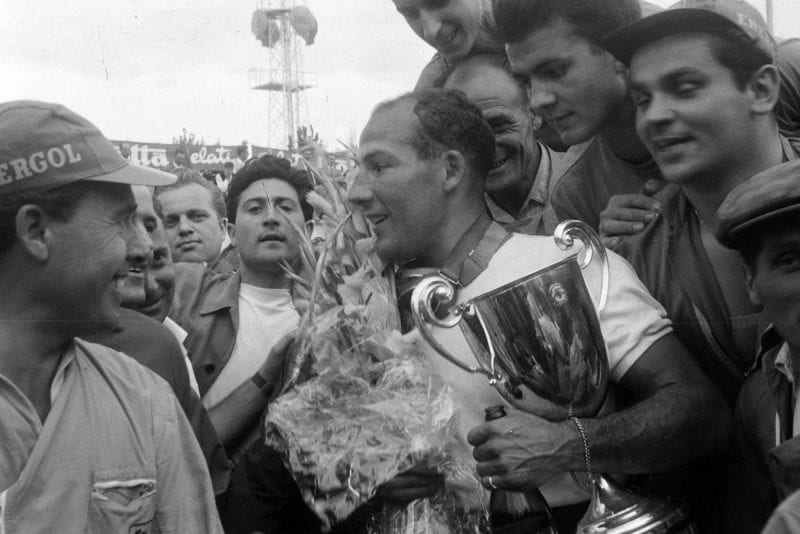
Moss enjoys the spoils of victory on the podium
Motorsport Images
MONZA MUSINGS
- If the Guild of Motoring Writers are looking for the driver of the year they might well look towards Harry Schell, for his brilliant efforts on the part of Vanwall in the French and Italian Grand Prix events.
- Moss finished the race with two litres of fuel in the tank, not enough for another lap.
- The Vanwall was so much faster than the Lancia/Ferrari and the Maserati that Schell had to overtake Moss and Collins on the over-run going into the south banking.
- The new Maserati was handling superbly in the south turn of the road circuit, and was visibly faster than all its competitors.
- Although the Pirelli tyres on the back of the winning Maserati looked bald, they could have done 10 or 15 more laps. there being 2 mm a plain rubber under the tread.
- The cockpit of the winning Maserati was spotless alter the race and Moss, did not have a speck of oil on his overalls – remarkable for a Maserati.
- Salvdori burst his own engine in practice and the factory lent him one for the race.
- Piotti made his name in the Italian GP, first for being bright enough to give Moss a push to the pits and secondly for being the first Italian driver to finish.
- Godia, the Spanish driver, was the first finisher to run through non-stop, the only others being Graffenried and Simon.
- Roland Bugatti and Raymond Mays were present but neither of their Grand Prix cars was entered – no comment.
- There was no regulation to forbid Moss being pushed by another car. Au oversight in drafting the regulations and no doubt it will result in a special one next year.
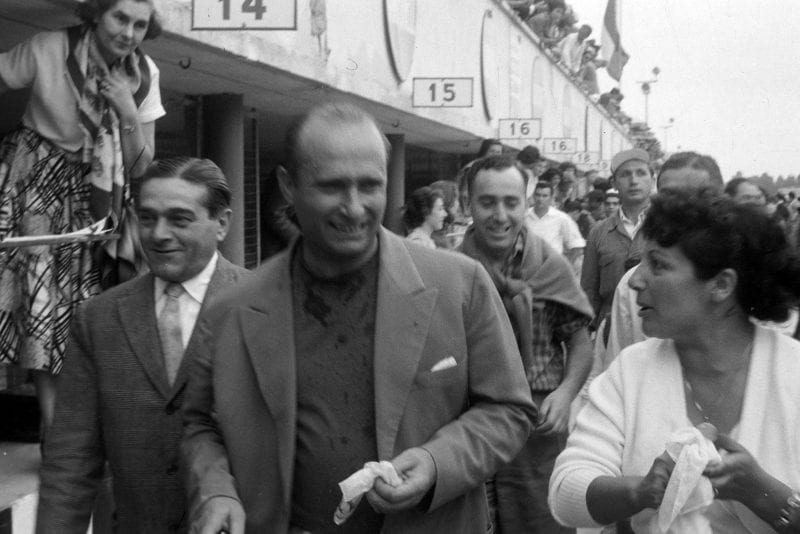
Fangio is content in the knowledge his fourth championship has been secured
Motorsport Images
MONZA POST MORTEM
After the race the Connaught that was placed third was stripped down and measured to ensure that it was of 93.5mm by 90 mm and 2.470cc as stated on the entry form. This was found to correct and the Italian Automobile Club engineers who inspected the car were most impressed with the internal cleanliness of the engine. On the Monday following the race the car was re-assembled and Leston and Rodney Clarke drove it round the circuit many times, carrying out tyre temperature tests for Avon’s technical man Don Turner, and doing brake and shock-absorber tests for Connaught.
Fairman’s car was unusable as both front spring mountings split on his extra lap after the finish and the car arrived at the pits with the wheels leaning inwards and the sump rubbing itself out on the ground until all the oil came out. The only thing wrong with Leston’s car was that the splines on the forward end of one of the rear torsion-bars had torn through the opposing splines on the anchoring arm.
After completing the whole Grand Prix, Flockhart’s car was able to lap the banked track at just on 160 mph without any effort at all.
The Vanwall team were not so fortunate, all their cars being out of action, except that Schell’s car could be driven but showed a tendency to pull sideways all the time indicating that something was amiss in the final-drive assembly. Once more none of them suffered from engine trouble.
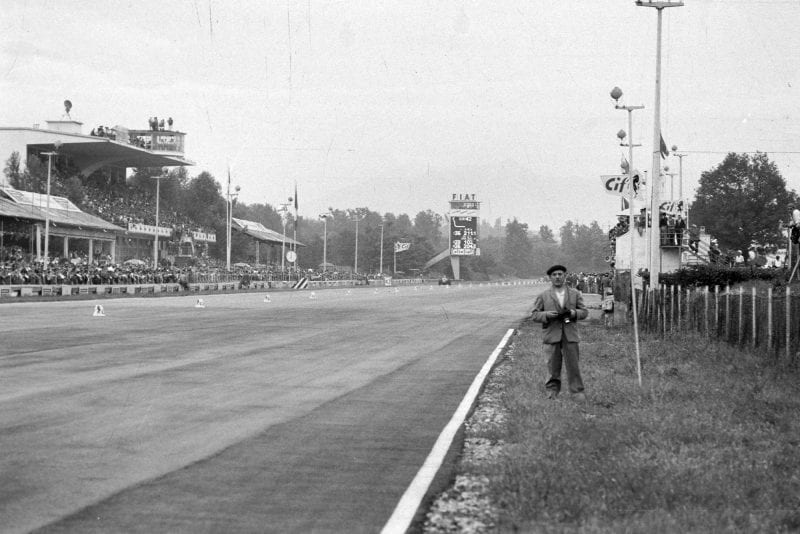
A cameraman finds his prime spot
Motorsport Images
On the Tuesday after the race a visit to Ferrari showed the Collins/Fangio car still under the official seals, awaiting the ACI engineers to measure it, but the wreck of Von Trips’ car was in the workshops and it had been discovered that his crash was due to a broken steering arm, exactly as suffered by Fangio and Musso.
Had the car been inspected immediately after the accident there would have been time to reinforce the arms on the team cars and thus avoided the loss of the race to Musso. No doubt had the practice crash happened to Fangio the car would been inspected closely; being Von Trips in his first try-out as a Grand Prix driver it was assumed that he had just gone into the corner too fast. Of the mortality or the Englebert tyres, Ferrari merely hoped that next time they would prove better.
The tachometers on the Lancia-Ferraris were all at 9,000 rpm with the exception of Musso’s which was at 8,600 rpm. The recommended limit given before the race was 8,500 rpm and it was obvious that no one had reached 9,000 in fifth gear, so clearly there had been some excited over-revving in the lower gears.
At Maserati the winning car was being stripped down for measurement and the bore and stroke verified as 84 by 75 mm and 2.494 cc; the internals of the engine were all in good condition, in spite of having revved to 13.700 rpm. Many people had assumed that Moss slowed for the last few laps because of engine trouble and to prove the contrary Behra was about to take it out on the Modena Autodromo. However, when fuel was poured into the tank it ran straight out at the bottom as it was split along one of the riveted seams, which accounted for Moss running out of fuel during the race.
The eight-cylinder Gordini was started up after the race and no water leak could be found: it transpired that the radiator filler cap was not tightened properly and water flew out at high revs, causing da Silva Ramos to abandon it on the far side of the circuit assuming something awful had happened.
NOTES ON THE CARS AT MONZA
Main technical interest at Monza lay in the two new Maseratis driven by Moss and Behra, for though most of the mechanical components were the same there had been much juggling with the disposition of the parts. Just before the bulkhead the chassis frame had been kinked outwards to make the cockpit wider and the engine, which was a normal-carburetter Grand Prix, was mounted at an angle towards the left, so that the prop.-shaft ran under the driver’s left knee and entered the gearbox/differential unit at an angle on the left side of the car. This entailed a new five-speed gearbox assembly, still on the same principle of lateral main and lay shafts but with the entry bevels well over to the near side.
The result of all this was that the driving seat was lowered and by mounting it slightly to the right of the cockpit it enabled the driver to sit a lot lower, with a resultant lower body line, the fuel tank being shaped to form a headrest behind the driver. The cockpit sides and Perspex windscreen were all carried round into the tail, so that only the driver’s head was visible, his shoulders and arms being inside the cockpit enclosure.
The fuel tank was mounted on rubber and positioned by spring-loaded bolts, instead of the usual flat steel straps, but the new idea was not a success for both tanks split. The bonnet was wrapped. closely round the engine and the carburetter intakes were covered by a tubular duct with open and at the front, covered with gauze on Behra’s car but fitted with a long extension forwards on to the nose on Moss’ car.
The radiators were lower and wider and had duets behind them to deflect the hot air downwards and out through the undertray. Suspension back and front, brakes, clutch and engine were all identical with the normal Grand Prix Maserati, but the steering-box was mounted on the chassis frame on the two new cars, instead of on the clutch housing as is normal.
In addition to all the modifications, the wheelbase was lengthened 20 mm and, with the lower centre of gravity, the handling was greatly improved, while the lower frontal area and more aerodynamic body accounted for the speed improvement, the horsepower claimed being in the order of 285-290 bhp. In practice both cars, as well as the normal ones, used single tail-pipes, but for the race they converted to the regular system of twin tail-pipes.
The Lancia/Ferraris showed no major changes since their last appearance, and, in fact, have not been radically changed since the beginning of the European season, the Scuderia Ferrari being content with steady engine development work. On the car driven by Collins a curved Perspex windscreen was used in place of the normal glass aero-screen. The six cars produced for practice were the sum total of Ferrari’s team of complete ears available for the event, together with a number of spare power units mounted in their travelling crates.
The Vanwalls were unchanged mechanically, but were fitted with de Dion tubes made of much thicker gauge steel in order to prevent breakages on the bumps of the banked track. As mentioned, the fuel load was limited in order not to bottom the suspension and the bump stops were reduced to allow the rear suspension more travel. Apart from these details the rest of the entry were unchanged.
1956 Italian Grand Prix race results
| Position | Driver | Team | Time | Points |
|---|---|---|---|---|
| 1 | Stirling Moss | Maserati | 2hr 23min 41.300sec | 9 |
| 2 | Peter Collins | Ferrari | SHC | 3 |
| 2 | Juan Manuel Fangio | Ferrari | +5.700sec | 3 |
| 3 | Ron Flockhart | Connaught Alta | +1 lap | 4 |
| 4 | Paco Godia | Maserati | +1 lap | 3 |
| NC | Luigi Musso | Ferrari | DNF | 0 |
| 5 | Jack Fairman | Connaught Alta | +3 laps | 2 |
| 6 | Luigi Piotti | Maserati | +3 laps | 0 |
| 7 | Toulo de Graffenried | Maserati | +4 laps | 0 |
| 8 | Juan Manuel Fangio | Ferrari | SHC | 0 |
| 8 | Eugenio Castellotti | Ferrari | +4 laps | 0 |
| 9 | Andre Simon | Gordini | +5 laps | 0 |
| NC | Umberto Maglioli | Maserati | SHC | 0 |
| NC | Jean Behra | Maserati | DNF | 0 |
| 10 | Gerino Gerini | Maserati | +8 laps | 0 |
| 11 | Roy Salvadori | Maserati | +9 laps | 0 |
| NC | Harry Schell | Vanwall | DNF | 0 |
| NC | Jean Behra | Maserati | DNF | 0 |
| NC | Bruce Halford | Maserati | DNF | 0 |
| NC | Maurice Trintignant | Vanwall | DNF | 0 |
| NC | Piero Taruffi | Vanwall | DNF | 0 |
| NC | Eugenio Castellotti | Ferrari | DNF | 0 |
| NC | Robert Manzon | Gordini | DNF | 0 |
| NC | Luigi Villoresi | Maserati | SHC | 0 |
| NC | Jo Bonnier | Maserati | DNF | 0 |
| NC | Alfonso de Portago | Ferrari | DNF | 0 |
| NC | Les Leston | Connaught Alta | DNF | 0 |
| NC | Hermano da Silva Ramos | Gordini | DNF | 0 |
